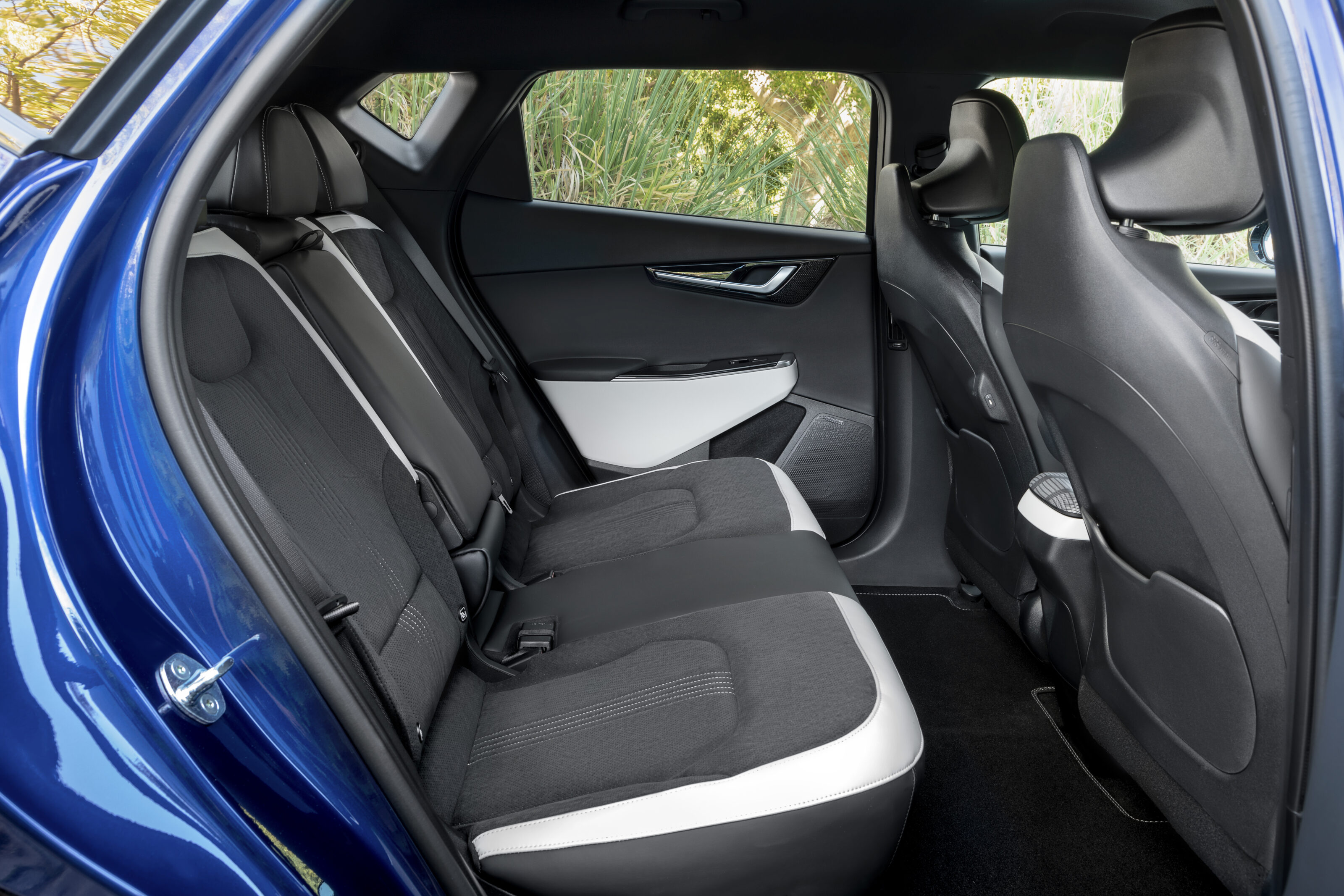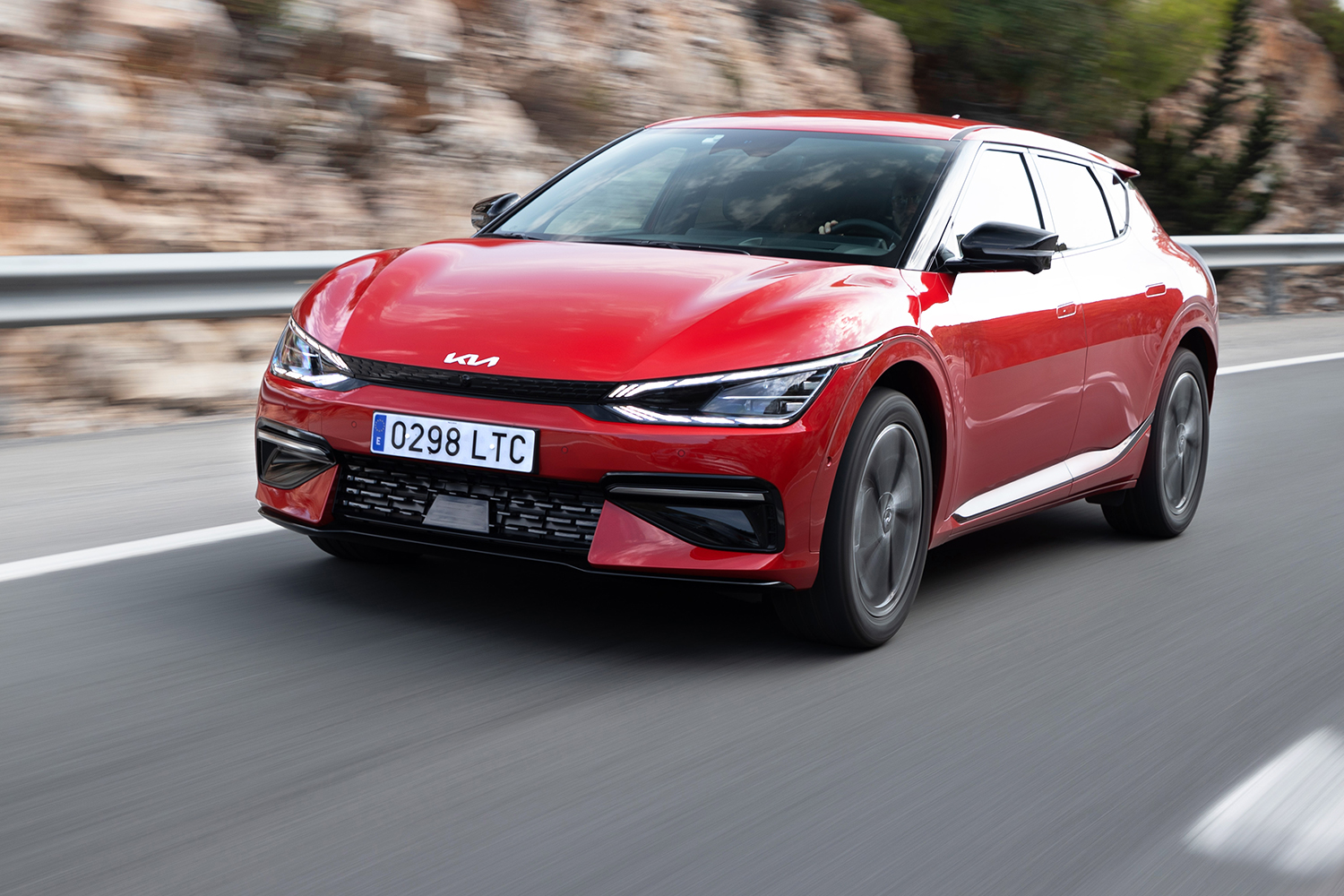Things we like
- Confident chassis
- Dramatic looks
- Roomy interior
Not so much
- Shallow load space
- Tesla still goes further, faster
- It won't be cheap
Meet Kia’s new halo car.
It’s not just that the all-electric EV6 is the first Kia in history designed from the wheels up to be battery-powered; the EV6 signals its virtues in other ways, too.
It looks dramatically modern. It has a roomy, well-finished interior. And it’s genuinely engaging to drive, with great steering, a confident chassis, and good performance.
One of 11 electric vehicles to be launched by Kia over the next five years, the EV6 is built on Hyundai Motor Group’s Electric-Global Modular Platform (E-GMP) and shares much of its hardware with Hyundai’s handsome Ioniq 5.
UPDATE, January 2023: Kia EV6 GT driven in Australia
“This isn’t even my final form”, chuckled the 239kW & 605Nm EV6 GT-Line last year. Now we understand… see our first drive review of the flagship EV6 GT, including a track test, at the link below.

Story continues…
That means the same battery packs and the choice of either single-motor rear-drive or dual-motor all-wheel-drive powertrain configurations.
But the Kia looks and feels a very different car to its Hyundai cousin. The Ioniq 5 has been designed to be the more comfort-oriented of these two E-GMP cars.
Just on 55mm lower overall than the Ioniq 5, 100mm shorter in the wheelbase, and with stiffer suspension, the EV6 is fundamentally an electric avatar of the Stinger, the sporty rear-drive Kia hatch that has no counterpart in Hyundai’s line-up.

The EV6 will initially be available in two trim levels – base and GT-Line – with a choice of 58kWh or 77.4kWh battery packs. Order the smaller battery and you’ll get a 125kW e-motor driving the rear wheels only, or a 173kW dual-motor setup and all-wheel drive.
Go for the bigger battery, and you’ll get 168kW in the single-motor version and 239kW in the dual-motor model.
The killer app in the EV6 arsenal will be the EV6 GT, which arrives later in 2022 with a 430kW dual motor powertrain that’s said to be good for 0-100km/h in 3.5 seconds and a top speed of 260km/h.

For the record, that’s more grunt, a quicker acceleration time, and a higher top speed than either Porsche’s Taycan 4S or Taycan 4S Cross Turismo.
A Kia that outperforms a Porsche? Yep.
Unless you need all-wheel drive, the single-motor GT-Line with the 77.4kW battery we sampled in southern England is perhaps the best all-rounder of the EV6 line-up, offering a good balance of performance and range plus high equipment levels.
With 168kW and 350Nm on tap to propel 1985kg, Kia claims a 0-100km/h time of about 7.0 seconds and a top speed of 185km/h.
Driving range, according to the WLTP test protocol, is 528 kilometres.

Those data points compare favourably with numbers for the single-motor, 77kWh battery Volkswagen ID4, an obvious rival to the Kia when it arrives in Australia sometime in 2023.
The ID4 has less power and torque – 150kW and 310Nm – and weighs 157kg more, so it isn’t as brisk as the Kia, taking at least half a second longer to get to 100km/h and able to go no faster than 160km/h. Claimed range for the ID4 is 10km more, however.
Where the Kia really stands apart from the Volkswagen, however, is the way it drives.

It starts with the steering. At 2.7 turns lock-to-lock, the EV6’s steering is sharper than the ID4’s (3.0 turns), and the effort strikes a nice balance between fluency and feel. More importantly, the relationship between steering inputs and the response from the front axle is resolutely linear.
The ride is firm, but not as relentlessly busy as that of the ID4. Front and rear spring rates that are stiffer than those on the Hyundai Ioniq 5 and are combined with thicker front and rear anti-roll bars, and what Kia calls ‘frequency selective’ dampers that feature an additional piston to adjust the amount of pressure on the rebound disc stack, allowing the rebound damping force to adapt dynamically to different input frequencies from changing road surfaces.
Kia says the shocks enable the EV6 to offer a slightly firmer, more planted ride when faced with lower frequency inputs, such as on a fast, winding road, and a more comfortable ride at highway speeds or over poor surfaces.

The EV6 changes direction crisply and consistently, its body motions tautly controlled. There’s much more grip from the front end than in the ID4, and you can use the instant-on torque to transfer weight to the rear axle and punch the car out of the corners. If you enjoy driving, this Kia has one of the most engaging EV chassis in the business.
The EV6 GT-Line comes standard with a comprehensive suite of driver aids, including lane keep assist, blind spot warning, forward collision warning, rear cross traffic alert, and intelligent LED headlights. What Kia calls Safe Exit Assist provides occupants exiting a parked EV6 a warning if a vehicle approaching from behind is detected.
Three drive modes – Eco, Normal, and Sport – can be actuated via a large button under the left spoke of the steering wheel. In simple terms, the modes change the weighting of the accelerator pedal, effectively encouraging the driver to make smoother and gentler inputs.

Six regenerative braking levels are offered, ranging from zero – which allows the EV6 to coast freely – to a mode that allows one pedal driving, the car slowing to a gentle halt the moment you lift off, and an auto mode. Drivers can switch between modes via paddles on the steering wheel.
We found the hot setup to be Sport mode, which allowed us to make the most of the powertrain’s instant-on response, with the lift-off regen dialled back to zero to enable the EV6 to flow effortlessly down the road.
You can click the left paddle once or twice to initiate just a hint of regenerative braking into open corners (the right paddle reduces the regen amount) or use the brake pedal to slow the car properly when needed. The brake system – discs front and rear, compared with the disc/drum setup on the ID4 – smoothly blends regenerative and mechanical braking.

Of course, the key question with any new EV is whether the real-word range stacks up against the promises on paper. Our time with the EV6 GT-Line suggests that driven without any due regard for saving electrons, you can expect a real-world range of 400km or better.
At the start of our drive, with the 77.4kWh battery topped up to 100 percent charge, the EV6’s electronic brain was predicting a range of 490km in Eco mode, 476km in Normal mode, and 460km in Sport mode.
After a 220km run through the south of England that included motorway cruising at 120km/h to 140km/h, some fast cut-and-thrust on empty two-lanes, and low speed running through villages and urban traffic, the readout showed a predicted range of 210km in Eco mode, 204km in Normal mode, and 200km in Sport mode.

The EV6 offers 800V ultra-fast charging capability that, on a 350kW ultra-rapid charger, enables the battery’s level of charge to be boosted from 10 percent to 80 percent in just 18 minutes.
Like the Hyundai Ioniq 5, the Kia EV6 is a surprisingly big car. At 4695mm long and 1890mm wide it’s just 115mm shorter and 10mm narrower than the seven-seat Sorento SUV. But it also has a wheelbase that’s 85mm longer and a roofline 150mm lower.
These two dimensions anchor a striking road presence accentuated by the hips over the rear wheels, the rising beltline aft of the B-pillar, a rear light bar that sweeps up and across the tail of the car and is profiled like a spoiler, and an aggressively chiseled nose.
Standard 19-inch alloy wheels shod with 235/55 Kumho Ecsta tyres, the high H-point – you’re sitting on top of a battery pack, after all – the long roof and the rear tailgate are all standard SUV/crossover cues, but visually the EV6 looks much more car-like.

The interior is very roomy – rear seat passenger accommodation is excellent, though you must duck under that low roofline to get in and out. The front seats are supportive and well-bolstered. The seats are upholstered in vegan leather and suede, and the dash is clad in materials made from recycled plastic bottles.
The view from the driver’s seat is dominated by a single screen that curves gently from behind the steering wheel across the dash to the centre of the car. The display in front of the driver comprises a digital instrument panel, while the centre display is a multi-function touch screen.
Not everything’s controlled by a screen – the EV6 still has light, wiper and turn signal stalks behind a steering wheel with mechanical rocker switches for functions such as adjusting cruise control speed on its spokes – stuff you can find by touch rather than taking your eyes off the road. The HVAC system is controlled by simple rotary dials, and forward and reverse gears are selected via large rotary controller on the cantilevered centre console.

VERDICT
Kia’s transformation over the past decade has been breathtaking, each new model better designed and better engineered than the last, to the point where the Korean brand now offers compelling alternatives to the Japanese and European mainstream in almost every segment.
Dramatic to look at, laden with useful technology, and enjoyable to drive, the Kia EV6 has what it takes to win over buyers in what is shaping up to be one of the most hotly contested segments in the industry.
Things we like
- Confident chassis
- Dramatic looks
- Roomy interior
Not so much
- Shallow load space
- Tesla still goes further, faster
- It won't be cheap






